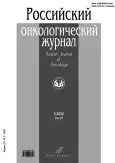Intracranial hemangiopericytoma: long-term surgical outcomes
- Authors: Andrushkevich O.M.1,2, Anisimov E.D.1, Zotov A.V.1, Gormolysova Е.V.1, Uzhakova E.K.1, Kasymov А.R.1, Abdilatipov А.А.1, Galushko Е.V.1, Kalinovskiy A.V.1,2,3
-
Affiliations:
- Federal Neurosurgical Center
- Novosibirsk State Medical University
- Krasnoyarsk State Medical University
- Issue: Vol 27, No 3 (2022)
- Pages: 107-116
- Section: Clinical investigations
- URL: https://bakhtiniada.ru/1028-9984/article/view/253246
- DOI: https://doi.org/10.17816/onco119849
- ID: 253246
Cite item
Abstract
BACKGROUND: According to 2021 WHS Classification, intracranial hemangiopericytomas or solitary fibrous tumors are rare meningeal neoplasms involving blood vessels and soft tissues. Such neoplasms are commonly classified as malignant due to their aggressive growth, metastasizing beyond the cranial cavity, and frequent recurrencies. Since these tumors rarely occur in neurosurgical patients, publications in Russian do not cover big cohorts of patients whose conditions would be assessed during both early and late observation periods.
AIM: The present study analyzed our experience in surgical treatment of hemangiopericytomas and its long-term results.
METHODS: The study was arranged as a single-center, pro-and retrospective trial that included hemangiopericytomas patients (n=17), whose tumors of different grades of malignancy (1–3) were operated at the Federal Neurosurgical Center in Novosibirsk from 2013 to 2021. The follow-up estimates included survivability; physical status (Karnofsky’s Scale); radicality; metastatic foci; need for postoperative chemo-and radiation therapy; adjuvant therapy effect on patients’ survivability, and delaying time to relapse.
RESULTS: In total, 17 patients were included. 11 of them underwent total hemangiopericytomas removal (65%), and 6 — subtotal removal (35%). Their survivability within the first year after the operation was 100%. As for the 5-year follow up, only 8 patients out of 17 were available, their mean observation time comprising 64.7 months. The 5-year survivability was 75% (6 out of 8 patients). A relapse occured in 3 out of 17 (17.5%). The mean delaying time comprised 67 months. 6 out of 17 patients (35%) underwent radiation therapy. Among the patients with total and subtotal removals who underwent postoperative radiation treatment neither a relapse nor tumor growth nor metastases were found.
CONCLUSION: Intracranial hemangiopericytoma is a rare malignant space-occupying neoplasm. Considering our experience and published data, its treatment requires aggressive tactics that includes a radical removal of the tumor followed by early irradiation of the tumor’s residual volume or bed either in a proton accelerator or a gamma-knife facility notwithstanding its malignancy grade. It is also recommended to extend the follow-up period for such patients to 10–15 years that should include annual cancer screening to detect local relapses and metastases.
Full Text
##article.viewOnOriginalSite##About the authors
Oleg M. Andrushkevich
Federal Neurosurgical Center; Novosibirsk State Medical University
Author for correspondence.
Email: andrushkevich_oleg@mail.ru
ORCID iD: 0000-0001-7297-2843
SPIN-code: 4017-5396
Russian Federation, Novosibirsk; Novosibirsk
Egor D. Anisimov
Federal Neurosurgical Center
Email: e_anisimov@neuronsk.ru
ORCID iD: 0000-0003-1858-3745
SPIN-code: 7127-1453
Russian Federation, Novosibirsk
Alexander V. Zotov
Federal Neurosurgical Center
Email: a_zotov@neuronsk.ru
ORCID iD: 0000-0002-8122-4879
SPIN-code: 5475-5031
Russian Federation, Novosibirsk
Еkaterina V. Gormolysova
Federal Neurosurgical Center
Email: e_gormolysova@neuronsk.ru
ORCID iD: 0000-0002-7996-8449
SPIN-code: 1386-5514
Russian Federation, Novosibirsk
Elena K. Uzhakova
Federal Neurosurgical Center
Email: e_uzhakova@neuronsk.ru
ORCID iD: 0000-0003-1684-4921
SPIN-code: 5583-2284
Russian Federation, Novosibirsk
Аgadadash R. Kasymov
Federal Neurosurgical Center
Email: a_kasymov@neuronsk.ru
ORCID iD: 0000-0002-0331-625X
SPIN-code: 6210-4104
Russian Federation, Novosibirsk
Аbdishukur А. Abdilatipov
Federal Neurosurgical Center
Email: a_abdilatipov@neuronsk.ru
ORCID iD: 0000-0001-5583-0050
SPIN-code: 8224-1306
MD, Cand. Sci. (Med.)
Russian Federation, NovosibirskЕvgeniy V. Galushko
Federal Neurosurgical Center
Email: e_galushko@neuronsk.ru
ORCID iD: 0000-0002-6018-1398
SPIN-code: 5071-6779
Russian Federation, Novosibirsk
Anton V. Kalinovskiy
Federal Neurosurgical Center; Novosibirsk State Medical University; Krasnoyarsk State Medical University
Email: a_kalinovskiy@neuronsk.ru
ORCID iD: 0000-0001-7003-5549
SPIN-code: 1905-4765
MD, Cand. Sci. (Med.)
Russian Federation, Novosibirsk; Novosibirsk; KrasnoyarskReferences
- Fountas KN, Kapsalaki E, Kassam M, et al. Management of intracranial meningeal hemangiopericytomas: outcome and experience. Neurosurg Rev. 2006;29(2):145–153. doi: 10.1007/s10143-005-0001-9
- Schiariti M, Goetz P, El-Maghraby H, et al. Hemangiopericytoma: long-term outcome revisited. J Neurosurg. 2011;114(3):747–755. doi: 10.3171/2010.6.JNS091660
- Mena H, Ribas JL, Pezeshkpour GH, et al. Hemangiopericytoma of the central nervous system: a review of 94 cases. Hum Pathol. 1991;22(1):84–91. doi: 10.1016/0046-8177(91)90067-Y
- Melone AG, D’Elia A, Santoro F, et al. Intracranial hemangiopericytoma — our experience in 30 years: a series of 43 cases and review of the literature. World Neurosurg. 2014;81(3-4):556–562. doi: 10.1016/j.wneu.2013.11.009
- Ciliberti MP, D’Agostino R, Gabrieli L, et al. The radiation therapy options of intracranial hemangiopericytoma: an overview and update on a rare vascular mesenchymal tumor. Oncol Rev. 2018;12(2):354. doi: 10.4081/oncol.2018.354
- Rutkowski MJ, Jian BJ, Bloch O, et al. Intracranial hemangiopericytoma: clinical experience and treatment considerations in a modern series of 40 adult patients. Cancer. 2012;118(6):1628–1636. doi: 10.1002/cncr.26411
- Simpson D. The recurrence of intracranial meningiomas after surgical treatment. J Neurol Neurosurg Psychiatry. 1957;20(1):22–39. doi: 10.1136/jnnp.20.1.22
- Tailakov ST, Shishkina LV, Sinyavin GV. Meningeal’nye gemangiopericitomy (obzor literatury). Surgical Practice. 2014;(3):79–82. (In Russ).
- Shkarubo AN, Tailakov ST, Shishkina LV, et al. Osobennosti lechenija meningeal’nyh gemangiopericitom. Surgical Practice. 2014;(2):80–84. (In Russ).
- Apra C, Mokhtari K, Cornu P, et al. Intracranial solitary fibrous tumors/hemangiopericytomas: first report of malignant progression. J Neurosurg. 2018;128(6):1719–1724. doi: 10.3171/2017.1.JNS162593
Supplementary files









